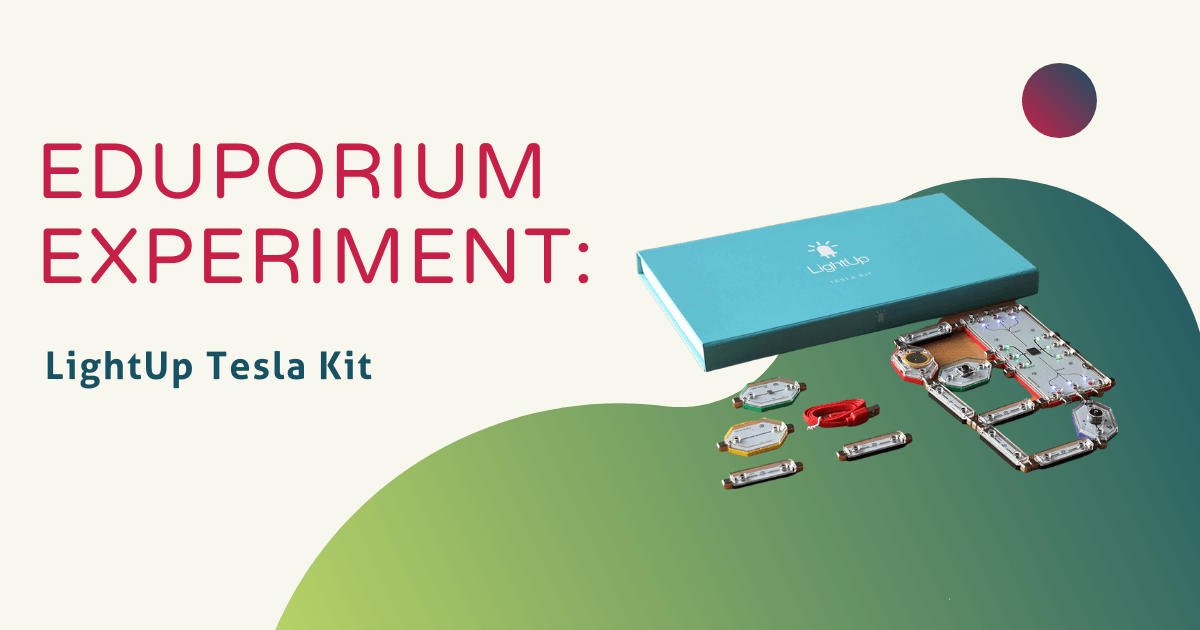At Eduporium, we very much appreciate EdTech tools that are engaging, enables creativity, and allows students to build Future Ready skills. Perhaps above those three characteristics, we value and promote tech tools that are progressive, meaning that, as students build certain skills, they’re more equipped to use certain tools more extensively. You can see this progressive approach in our store as many of the product lines we carry start on the simple side and then allow kids to work up to using similar but more complex tools. That’s exactly the case with the focus of this week’s Eduporium Experiment, the LightUp Tesla Kit.
To explain all that the LightUp Tesla is designed to accomplish, let’s first take a minute to examine its predecessor, the LightUp Edison Kit. This interactive kit is used to teach kids the basics of circuitry in a hands-on way. It comes with modular and magnetic pieces that they can use to build circuits that real electricity flows through. If they’re not connecting the pieces in the correct way, they won’t stick. Plus, kids can take a picture of their circuit using the LightUp Learning app and it will tell them if they’ve built it correctly, making the LightUp Edison a very unique and useful tool for exploring the beginnings of circuitry.
The LightUp Tesla Kit is essentially the same in the construction phase of building the circuits. The difference is that, once the circuits are built, kids can program them! Not only are they gaining exposure to circuitry and engineering, LightUp Tesla encourages them to learn one of the most important STEM skills of today. Like so many of the robotics tools used in classrooms around the world, all the LightUp Tesla needs is a tablet and a Bluetooth connection to allow kids to start programming. It’s even compatible with the pieces of the LightUp Edison Kit, so integrating it into learning is pretty easy and stays in line with the progressive principle.
As soon as I took it out of the box, I learned that the block that makes the programming possible is the microcontroller block, which is a new addition in the Tesla Kit. Having used the LightUp Edison Kit before, I knew that I would need the LightUp Learning app, so the next thing I did was download that. It works great on iOS devices, by the way. The app includes introductory projects, so all I had to do was select the kit I was using (Tesla) and pair the tablet with the microcontroller block, which was a piece of cake.
Essentially, as I found out while building my mini burglar alarm, the LightUp Tesla Kit is designed to get kids programming right from an iPad. The devices they are able to code are small enough that they only need a little bit of space for construction, but, more importantly, they can be controlled from a device they are likely already familiar with. The components in the Tesla Kit also act as sensors, so students can use them to initiate their coding. For example, they can create a program that uses light to activate, introducing them to the different ways to use programming in the real world!
I can say without any reservations that the LightUp Tesla Kit is very easy to use and provides a perfect, age-appropriate replication of programming for elementary school students. To add it to your STEM classroom or makerspace for this upcoming school year, visit the Eduporium store now and sign up for an Educator Discount account to get it for less! Be sure to look out for next week’s edition of the Eduporium Experiment as well when we break down the littleBits Code Kit for you a week from today!



